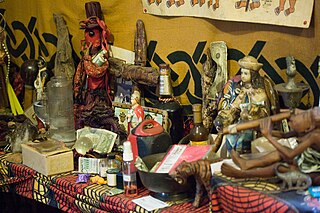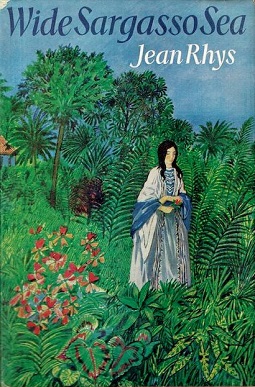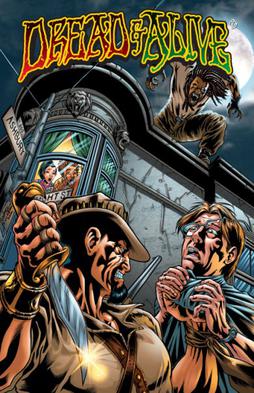
Uncle Tom's Cabin; or, Life Among the Lowly is an anti-slavery novel by American author Harriet Beecher Stowe. Published in two volumes in 1852, the novel had a profound effect on attitudes toward African Americans and slavery in the U.S., and is said to have "helped lay the groundwork for the [American] Civil War".

African diaspora religions, also described as Afro-American religions, are a number of related beliefs that developed in the Americas in various nations of the Caribbean, Latin America and the Southern United States. They derive from traditional African religions with some influence from other religious traditions, notably Christianity and Islam.

Wide Sargasso Sea is a 1966 novel by Dominican-British author Jean Rhys. The novel serves as a postcolonial and feminist prequel to Charlotte Brontë's novel Jane Eyre (1847), describing the background to Mr. Rochester's marriage from the point of view of his wife Antoinette Cosway, a Creole heiress. Antoinette Cosway is Rhys's version of Brontë's "madwoman in the attic". Antoinette's story is told from the time of her youth in Jamaica, to her unhappy marriage to an English gentleman, Mr. Rochester, who renames her Bertha, declares her mad, takes her to England, and isolates her from the rest of the world in his mansion. Wide Sargasso Sea explores the power of relationships between men and women and discusses the themes of race, Caribbean history, and assimilation as Antoinette is caught in a white, patriarchal society in which she fully belongs neither to Europe nor to Jamaica.

Obeah, also spelled Obiya or Obia, is a broad term for African diasporic religious, spell-casting, and healing traditions found primarily in the former British colonies of the Caribbean. These practices derive much from West African traditions but also incorporate elements of South Asian origin. Many of those who practice these traditions avoid the term Obeah due to the word's pejorative connotations in many Caribbean societies.

Sugar plantations in the Caribbean were a major part of the economy of the islands in the 18th, 19th, and 20th centuries. Most Caribbean islands were covered with sugar cane fields and mills for refining the crop. The main source of labor, until the abolition of chattel slavery, was enslaved Africans. After the abolition of slavery, indentured laborers from India, China, Portugal and other places were brought to the Caribbean to work in the sugar industry. These plantations produced 80 to 90 percent of the sugar consumed in Western Europe, later supplanted by European-grown sugar beet.

Slavery in the British and French Caribbean refers to slavery in the parts of the Caribbean dominated by France or the British Empire.
A Small Place is a work of creative nonfiction published in 1988 by Jamaica Kincaid. A book-length essay drawing on Kincaid's experiences growing up in Antigua, it can be read as an indictment of the Antiguan government, the tourist industry and Antigua's British colonial legacy, which includes slavery.
Thomas Thistlewood was an English-born planter and diarist who spent the majority of his life in the British colony of Jamaica. Born in Tupholme, Lincolnshire, Thistlewood migrated to the western end of Jamaica where he worked as a plantation overseer before acquiring ownership over several slave plantations. During his time in Jamaica, he kept a diary in which Thistlewood recorded numerous aspects of his life. Eventually spanning over 14,000 pages, the diary detailed the brutal mistreatment of the slaves he held authority over, first as an overseer then as a plantation owner.

Small Island is a novel written by British author Andrea Levy.

Dread & Alive is a Jamaican-inspired multimedia series spanning comic books, novels, and reggae music created and written by Nicholas Da Silva, a multidisciplinary artist and musician known professionally as Zoolook. Zoolook is also the founder and editor-in-chief of IRIE magazine. Dread & Alive follows Drew McIntosh before, during and after being empowered by a sacred amulet created by the ancient Jamaican Maroons.
Tivoli Gardens is a neighbourhood in Kingston, Jamaica. Developed as a renewal project between 1963 and 1965, the neighbourhood continued to suffer from poverty. By the late twentieth century it had become a center of drug trafficking activity and social unrest. Repeated confrontations took place between law enforcement and gunmen in the neighbourhood in 1997, 2001, 2005, 2008, and 2010.
Igbo people in Jamaica were trafficked by Europeans onto the island between the 18th and 19th centuries as enslaved labour on plantations. Igbo people constituted a large portion of the African population enslaved people in Jamaica. Jamaica received the largest number of enslaved people from the biafra region than anywhere else in the diaspora during the slave trade. Some slave censuses detailed the large number of enslaved Igbo people on various plantations throughout the island on different dates throughout the 18th century. Their presence was a large part in forming Jamaican culture, Igbo cultural influence remains in language, dance, music, folklore, cuisine, religion and mannerisms. In Jamaica the Igbo were often referred to as Eboe or Ibo. There are a substantial number of Igbo language loanwords in Jamaican Patois. Igbo people mostly populated the northwestern section of the island.
Buckra or Backra is a term of West African origin. It is mainly used in the Caribbean and the Southeast United States. Originally, it was used by slaves to address their white owners. Later, the meaning was broadened to generally describe white people.

Marlon James is a Jamaican writer. He is the author of five novels: John Crow's Devil (2005), The Book of Night Women (2009), A Brief History of Seven Killings (2014), which won him the 2015 Man Booker Prize, Black Leopard, Red Wolf (2019), and Moon Witch, Spider King (2022). Now living in Minneapolis, Minnesota, in the U.S., James teaches literature at Macalester College in St. Paul, Minnesota. He is also a faculty lecturer at St. Francis College's Low Residency MFA in Creative Writing.

A Brief History of Seven Killings is the third novel by Jamaican author Marlon James. It was published in 2014 by Riverhead Books. The novel spans several decades and explores the attempted assassination of Bob Marley in Jamaica in 1976 and its aftermath, through the crack wars in New York City in the 1980s, and a changed Jamaica in the 1990s.

Myal is an Afro-Jamaican spirituality. It developed via the creolization of African religions during the slave era in Jamaica. It incorporates ritualistic magic, spiritual possession and dancing. Unlike Obeah, its practices focus more on the connection of spirits with humans. Over time, Myal began to meld with Christian practices and created the religious tradition known as Revivalism.
The traditional Jamaican Maroon religion, otherwise known as Kumfu, was developed by a mixing of West and Central African religious practices in Maroon communities. While the traditional religion of the Maroons was absorbed by Christianity due to conversions in Maroon communities, many old practices continued on. Some have speculated that Jamaican Maroon religion helped the development of Kumina and Convince. The religious Kromanti dance is still practiced today but not always with the full religious connotation as in the past.

Girl, Woman, Other is the eighth novel by Bernardine Evaristo. Published in 2019 by Hamish Hamilton, it follows the lives of 12 characters in the United Kingdom over the course of several decades. The book was the co-winner of the 2019 Booker Prize, alongside Margaret Atwood's The Testaments.

The Blood of the Vampire is a Gothic novel by Florence Marryat, published in 1897. The protagonist, Harriet Brandt, is a mixed-race psychic vampire who kills unintentionally. The novel follows Harriet after she leaves a Jamaican convent for Europe, and her ill-fated attempts to integrate with Victorian society.
Green Park Estate was one of several sugar plantations owned by William Atherton and his heirs. It was located in Trelawny Parish, south of Falmouth, Jamaica. By the early nineteenth century, at least 533 people were enslaved there producing mainly sugar and rum.













